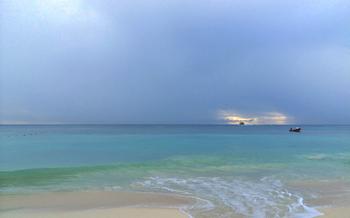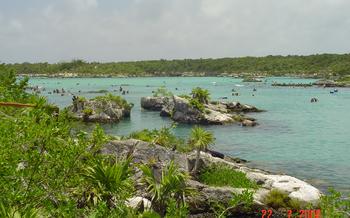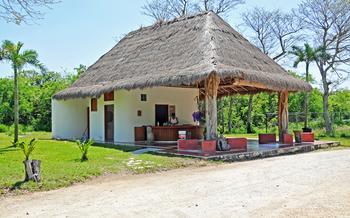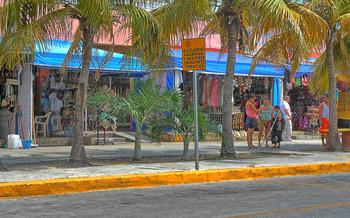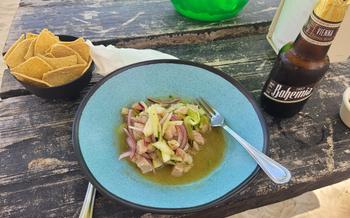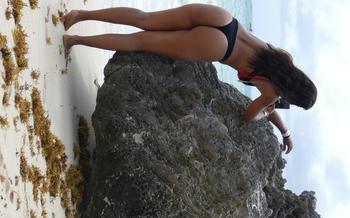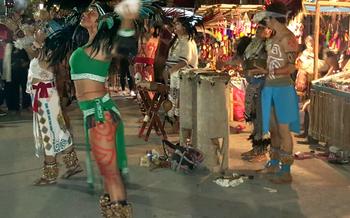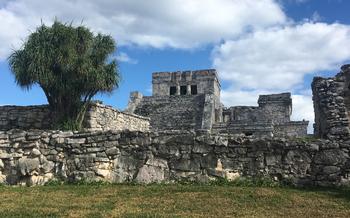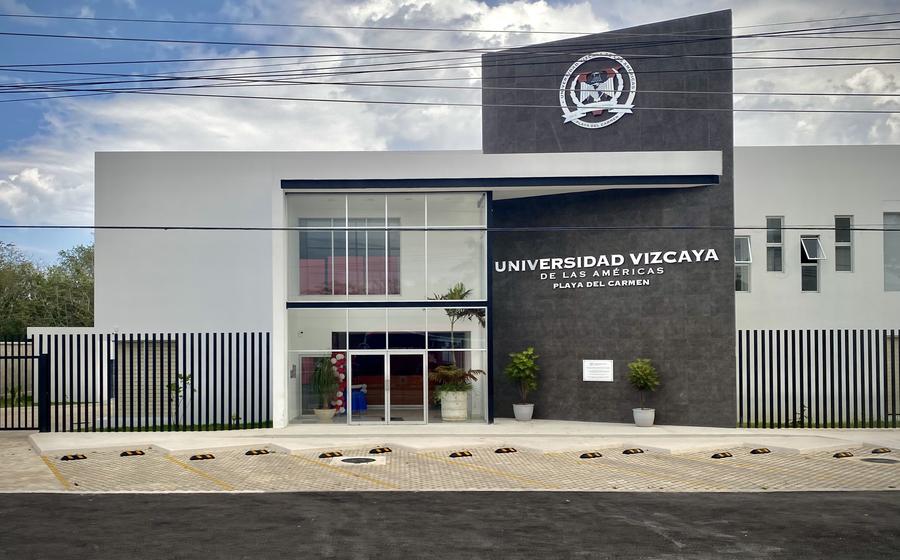
Cenote Jardín del Eden
- The Cenote Jardín del Eden: A Natural Wonder
- Entering the Cenote
- Exploring the Cenote
- Swimming and Snorkeling
- Photography and Videography: Capturing the Enchanting Beauty of the Cenote Jardín del Eden
- Cultural Significance
- Conservation Efforts
- Nearby Attractions
- Getting There
- When to Visit
- Insider Tip: Uncover Hidden Gems and Local Secrets
The Cenote Jardín del Eden: A Natural Wonder
Cenote Jardín del Eden, nestled in the heart of Mexico's Riviera Maya, is a captivating natural wonder that beckons adventurers and nature enthusiasts alike. This breathtaking sinkhole, formed by the collapse of limestone bedrock and filled with crystal-clear groundwater, offers a glimpse into the region's rich geological history and ecological significance.
Geologically, the cenote is a testament to the power of water erosion and dissolution. Over millennia, rainwater has seeped into the porous limestone, creating a network of underground chambers and tunnels. The collapse of these structures resulted in the formation of the cenote, exposing the hidden beauty beneath the surface.
The cenote is a haven for diverse flora and fauna, contributing to the region's rich biodiversity. Lush vegetation surrounds the cenote, providing a habitat for tropical birds, insects, and reptiles. The crystal-clear waters are home to a variety of fish, turtles, and other aquatic creatures, making it a paradise for snorkelers and divers.
The Cenote Jardín del Eden is easily accessible, located just a short drive from the popular tourist destination of Playa del Carmen. Its proximity to other attractions, such as the ancient Mayan ruins of Tulum and the vibrant coral reefs of Cozumel Island, makes it a convenient stop on any Riviera Maya itinerary.
Entering the Cenote
Before embarking on your cenote adventure, safety should be your top priority. The Cenote Jardín del Eden has well-established safety measures in place to ensure a safe and enjoyable experience for all visitors. Lifeguards are present during operating hours to monitor and assist as needed. They provide safety briefings and guidelines before allowing access to the cenote. It's essential to follow their instructions and adhere to the safety regulations for your well-being and the preservation of the cenote's delicate ecosystem.
Equipment Needed
To fully enjoy your cenote experience, consider bringing appropriate gear. A swimsuit is a must, and water shoes or sandals with good grip are recommended to navigate the slippery surfaces around the cenote. If you plan to swim or snorkel, consider renting or bringing your own snorkel gear. For diving enthusiasts, specialized diving equipment, including tanks, regulators, and dive lights, can be rented from local dive shops. It's important to ensure that your equipment is in good condition and fits properly for a safe and comfortable dive.
Fees and Permits
To access the Cenote Jardín del Eden, a modest entrance fee is usually charged. This fee contributes to the maintenance and conservation of the cenote. In some cases, permits may be required for certain activities, such as diving or cave exploration. These permits can be obtained from local authorities or tour operators. It's advisable to inquire about fees and permits before your visit to avoid any inconvenience.
Guided Tours vs. Self-Exploration
Whether you opt for a guided tour or self-exploration depends on your preferences and experience level. Guided tours offer the advantage of having a knowledgeable guide who can provide insights into the cenote's history, geology, and ecology. They can also lead you to hidden spots and ensure your safety.
For experienced adventurers who are comfortable exploring independently, self-exploration allows for a more intimate and flexible experience. It provides the freedom to explore at your own pace and discover the cenote's wonders on your own terms. However, it's important to have a good understanding of the cenote's layout, potential hazards, and safety guidelines before venturing out on your own.
Exploring the Cenote
The Cenote Jardín del Eden boasts a captivating layout, characterized by a large open chamber that gradually transitions into deeper, narrower passages. The crystal-clear water provides excellent visibility, allowing visitors to admire the intricate rock formations, stalactites, and stalagmites that adorn the cenote's walls and ceiling. The water temperature remains pleasantly cool, inviting swimmers to immerse themselves in its refreshing depths.
Underwater, the cenote reveals a fascinating array of features. Divers and snorkelers can encounter submerged trees, ancient fossils, and a diverse array of aquatic life. Schools of colorful fish dart through the water, while turtles, eels, and the occasional ray glide gracefully past. The cenote's unique ecosystem supports a variety of plant and animal species, including endemic species found nowhere else in the world.
Visitors may also encounter halocline, a layer of water with different density and salinity, creating a striking visual effect. This phenomenon occurs when freshwater from the cenote mixes with saltwater from the nearby ocean, resulting in a distinct separation of the two water bodies. The halocline adds to the cenote's allure and provides another reason to explore its depths.
Swimming and Snorkeling
The Cenote Jardín del Edén offers pristine conditions for swimming and snorkeling, inviting visitors to immerse themselves in its crystal-clear waters. The cenote's calm and shallow areas are ideal for beginners, allowing them to float effortlessly and admire the stunning underwater scenery. For more experienced swimmers and snorkelers, venturing into the deeper sections reveals a captivating world of underwater caves, tunnels, and swim-throughs.
The water visibility in the cenote is exceptional, providing snorkelers with an unparalleled view of the diverse marine life that inhabits its depths. Colorful tropical fish, graceful rays, and gentle sea turtles are just a few of the creatures that can be spotted during an underwater exploration. The cenote's crystal-clear waters also make it an excellent spot for underwater photography, allowing visitors to capture breathtaking images of the vibrant marine life and the stunning rock formations that adorn the cenote's interior.
Photography and Videography: Capturing the Enchanting Beauty of the Cenote Jardín del Eden
The Cenote Jardín del Eden presents a photographer's paradise, offering a kaleidoscope of colors, unique rock formations, and vibrant underwater life. Capturing the essence of this natural wonder through the lens of a camera can be an immensely rewarding experience.
For photography enthusiasts, the cenote provides a wealth of opportunities to showcase their skills. The crystal-clear waters and abundant natural light create ideal conditions for capturing stunning images of the cenote's mesmerizing depths. Whether you're using a waterproof camera or a housing, the possibilities for underwater photography are endless.
Don't miss the chance to capture the vibrant marine life that calls the cenote home. From colorful fish darting among the coral reefs to graceful sea turtles gliding through the water, the cenote offers a diverse array of subjects to photograph.
For a truly immersive experience, consider bringing a GoPro or other action camera to document your underwater adventures. The cenote's unique geological features, combined with the diverse wildlife, make for captivating footage that will transport viewers to another world.
To create memorable shots, experiment with different angles and perspectives. Swim close to the surface to capture the interplay of light and water, or dive deeper to reveal the hidden wonders of the cenote's underwater caves.
Remember to respect the cenote's ecosystem by avoiding touching or disturbing the wildlife. Use natural light whenever possible to minimize the impact on the delicate underwater environment.
Whether you're a seasoned photographer or just starting out, the Cenote Jardín del Eden offers a truly unforgettable opportunity to capture the beauty and wonder of nature through the lens of your camera.
Cultural Significance
The Cenote Jardín del Eden holds deep cultural significance for the Mayan people, who have revered cenotes as sacred places since ancient times. Mayans believed that cenotes were portals to the underworld, Xibalba, and that they possessed mystical powers. Rituals and ceremonies were often performed at cenotes, and offerings were made to the gods in the form of precious objects, food, and even human sacrifices.
Local legends and folklore surrounding the Cenote Jardín del Eden are still passed down through generations. One popular tale tells of a young Mayan princess who drowned in the cenote while trying to escape from an arranged marriage. Her spirit is said to reside in the cenote, protecting it from harm and guiding lost souls.
Visiting the Cenote Jardín del Eden offers a unique opportunity to connect with the rich cultural heritage of the Mayans. By respecting local traditions and customs, visitors can contribute to the preservation of this sacred site and its cultural significance.
Conservation Efforts
The Cenote Jardín del Eden is a precious natural treasure that requires careful conservation efforts to preserve its pristine condition for future generations. Sustainable tourism practices play a crucial role in protecting the cenote's delicate ecosystem. Visitors are encouraged to minimize their environmental impact by adhering to responsible diving and snorkeling techniques, avoiding touching or disturbing the underwater life, and properly disposing of waste.
Local conservation initiatives are actively working to safeguard the cenote and its surroundings. These initiatives often involve monitoring water quality, implementing sustainable tourism guidelines, and educating visitors about the importance of conservation. By supporting these initiatives, tourists can contribute directly to the preservation of this natural wonder.
Respecting the cenote's natural beauty and ecological significance is essential for its long-term health. Visitors should prioritize sustainable choices, such as using biodegradable sunscreens, avoiding littering, and opting for eco-friendly tour operators. By embracing responsible tourism practices, visitors can help ensure that the Cenote Jardín del Eden remains a thriving natural paradise for years to come.
Nearby Attractions
The Cenote Jardín del Eden is surrounded by a plethora of other natural and cultural attractions that are worth exploring. For those seeking an adrenaline-fueled adventure, the Xcaret Eco Theme Park offers a range of thrilling activities, including zip-lining, swimming with dolphins, and exploring underground rivers.
Just a short drive away, the Rio Secreto Underground River beckons with its crystal-clear waters and stunning stalactite and stalagmite formations. History buffs can delve into the ancient Mayan civilization at the Tulum Mayan Ruins, perched dramatically on a cliff overlooking the Caribbean Sea.
For those who prefer to immerse themselves in marine life, a trip to Cozumel Island is a must. This world-renowned diving destination boasts vibrant coral reefs, teeming with colorful tropical fish and other marine creatures.
Whether you seek adventure, history, or simply relaxation, the area surrounding the Cenote Jardín del Eden offers something for every traveler.
Getting There
Reaching the Cenote Jardín del Eden is a breeze, with multiple transportation options available. If you prefer the freedom of self-driving, rental cars are readily available in Playa del Carmen. The drive is scenic, taking you through lush Mayan jungle landscapes. Ample parking is available at the cenote, ensuring a hassle-free visit.
For those who prefer a more organized experience, guided tours are offered by local operators. These tours typically include transportation to and from your hotel, providing a convenient and stress-free way to explore the cenote. Opting for a guided tour also allows you to tap into the expertise of local guides who can share fascinating insights into the cenote's history, geology, and ecosystem.
Detailed directions to the Cenote Jardín del Eden can be easily found online or obtained from your hotel concierge. The roads leading to the cenote are well-maintained, making it accessible to all types of vehicles. Just follow the signs and enjoy the scenic journey to this natural wonder.
When to Visit
The best time to visit the Cenote Jardín del Eden is during the dry season, which typically runs from November to April. During this time, the weather is mostly sunny and dry, with little to no rain. The water levels in the cenote are also lower, making it easier to explore the underwater caves and tunnels.
Avoid visiting during the rainy season, which runs from May to October. During this time, the weather is more humid and rainy, and the water levels in the cenote can rise significantly, making it more difficult to explore.
Peak season for tourism in Playa del Carmen is from December to March. If you want to avoid the crowds, consider visiting during the shoulder months of April, May, September, and October.
Off-season discounts and promotions are often available during the shoulder months and rainy season. This can be a great time to visit if you're on a budget.
In addition to the weather, water levels can also affect your experience at the Cenote Jardín del Eden. During the dry season, the water levels are lower, making it easier to explore the underwater caves and tunnels. During the rainy season, the water levels can rise significantly, making it more difficult to explore.
Insider Tip: If you're visiting during the dry season, be sure to bring a flashlight to help you explore the underwater caves and tunnels.
Insider Tip: Uncover Hidden Gems and Local Secrets
For an unforgettable experience, venture off the beaten path and seek out the hidden treasures of the area. Swim to secluded spots within the cenote, where you can enjoy a tranquil moment surrounded by untouched nature. Explore lesser-known cenotes nearby, each with its unique charm and fewer crowds. Connect with local guides who can share authentic stories, cultural insights, and lead you to hidden gems that only locals know about. Remember to pack essentials such as water shoes for navigating rocky terrain and towels for drying off after a refreshing dip. Embracing these insider tips will transform your visit into an extraordinary adventure.
